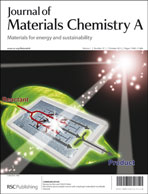PCDTBT: en route for low cost plastic solar cells
Abstract
Since its inception in 1995, significant advances in the field of bulk heterojunction (BHJ) solar cells have been made and polymeric semiconductors are now considered to be one of the most promising ways to lower the cost of the energy generated by solar cells. Power conversion efficiencies (PCEs) are now reaching the threshold values for commercialisation (9.2% for single-layer BHJ and 10.6% for tandem devices). PCDTBT, a


 Please wait while we load your content...
Please wait while we load your content...